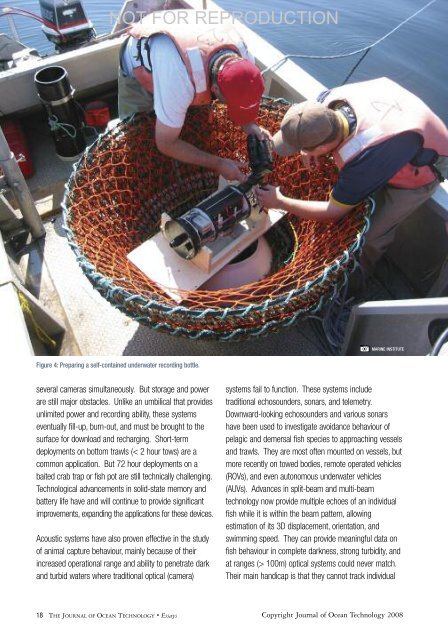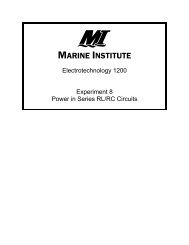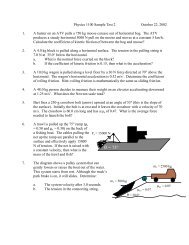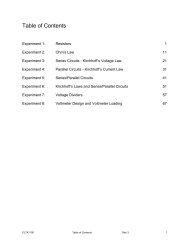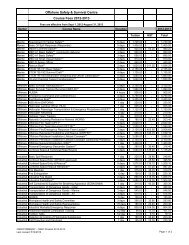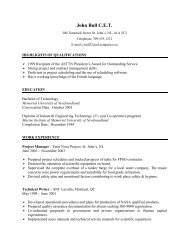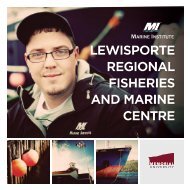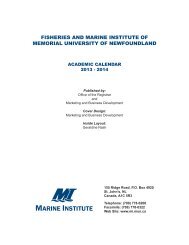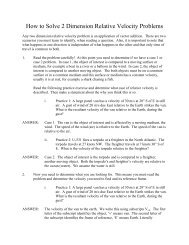NOT FOR REPRODUCTIONMARINE INSTITUTEFigure 4: Preparing a self-contained underwater recording bottle.several cameras simultaneously. But storage <strong>and</strong> powerare still major obstacles. Unlike an umbilical that providesunlimited power <strong>and</strong> recording ability, these systemseventually fill-up, burn-out, <strong>and</strong> must be brought to thesurface for download <strong>and</strong> recharging. Short-termdeployments on bottom trawls (< 2 hour tows) are acommon application. But 72 hour deployments on abaited crab trap or fish pot are still technically challenging.Technological advancements in solid-state memory <strong>and</strong>battery life have <strong>and</strong> will continue to provide significantimprovements, exp<strong>and</strong>ing the applications for these devices.Acoustic systems have also proven effective in the studyof animal capture behaviour, mainly because of theirincreased operational range <strong>and</strong> ability to penetrate dark<strong>and</strong> turbid waters where traditional optical (camera)systems fail to function. These systems includetraditional echosounders, sonars, <strong>and</strong> telemetry.Downward-looking echosounders <strong>and</strong> various sonarshave been used to investigate avoidance behaviour ofpelagic <strong>and</strong> demersal fish species to approaching vessels<strong>and</strong> trawls. They are most often mounted on vessels, butmore recently on towed bodies, remote operated vehicles(ROVs), <strong>and</strong> even autonomous underwater vehicles(AUVs). Advances in split-beam <strong>and</strong> multi-beamtechnology now provide multiple echoes of an individualfish while it is within the beam pattern, allowingestimation of its 3D displacement, orientation, <strong>and</strong>swimming speed. They can provide meaningful data onfish behaviour in complete darkness, strong turbidity, <strong>and</strong>at ranges (> 100m) optical systems could never match.Their main h<strong>and</strong>icap is that they cannot track individual18 THE JOURNAL OF OCEAN TECHNOLOGY • EssaysCopyright Journal of Ocean Technology 2008
NOT FOR REPRODUCTIONfish for more than a few seconds. So many observationsare typically aggregated to give researchers an indicationof what fish are doing at the school level.Telemetry is a complimentary acoustic technology thatoperates at the scale of the individual animal. Usingsmall animal-borne transmitters, researchers track themovements <strong>and</strong> behaviour of individual animals prior,during, <strong>and</strong> after an encounter with fishing gear. Attachingthe transmitters (called “tagging”) is usually the firstchallenge. Every effort must be made to ensure thecatching, h<strong>and</strong>ling, anesthetizing, <strong>and</strong> tagging doesn’taffect long-term behaviour once the animal is released.Different techniques have been developed, includingexternal attachment, implantation in the body cavity, <strong>and</strong>in the case of larger fish like cod, insertion into thestomach. In an effort to minimize stress on the animals,some have even developed in situ techniques in whichthe animals are tagged underwater, including voluntaryingestion of transmitters wrapped in bait (Atlantic cod offFigure 5: Attaching a camera <strong>and</strong> recording bottle to the headline of abottom trawl.Newfoundl<strong>and</strong>),underwatersurgery bySCUBA divers(rockfish offCalifornia), <strong>and</strong>subsea roboticsurgery pilotedfrom the surface(redfish offIcel<strong>and</strong>). Oncethe animals aretagged, anumber oftechniques canMARINE INSTITUTEFigure 6: Underwater observations of Atlanticcod inside baited fish pots.be used to “track” the animals <strong>and</strong> monitor their behaviour.Studies investigating capture behaviour in relation tofishing gear usually employ an array of fixed (listening)hydrophones in a relatively confined study area. Basedon differences in the time of arrival of the pings emittedfrom the transmitters at the hydrophones, accuratepositions of the animals can be computed every fewseconds. This technology has been used to study thereaction distance <strong>and</strong> search behaviour of crab towardbaited traps, cod toward baited longlines, as well as optimalreaction distance of plaice <strong>and</strong> cod toward approachingbottom trawls at different times of day <strong>and</strong> year.Looking ForwardAs we look to the future, it is reasonably apparent thatthe commercial fishing industry worldwide will continue toface increasing pressures, including new regulations,bycatch restrictions, species- <strong>and</strong> size-selectivity, <strong>and</strong>concerns over ecosystem impact. More than ever, theindustry is now faced with re-inventing fishing as asustainable <strong>and</strong> conservation-oriented means of exploitingthe oceans natural resources. This is a complex issuethat requires time <strong>and</strong> resources to resolve.MARINE INSTITUTEPart of the solution to this challenge is a betterunderst<strong>and</strong>ing of how animals interact with fishing gear.What kind of better underst<strong>and</strong>ing you ask? The answerI believe is two-fold:Copyright Journal of Ocean Technology 2008All the Fishes that Swim, Vol. 3, No. 2, 2008 19


